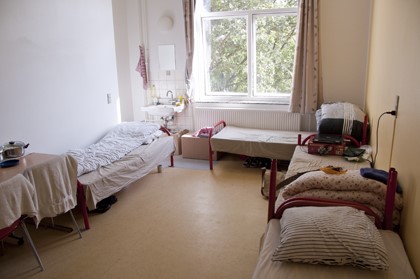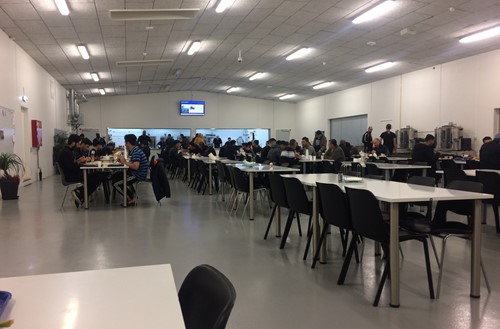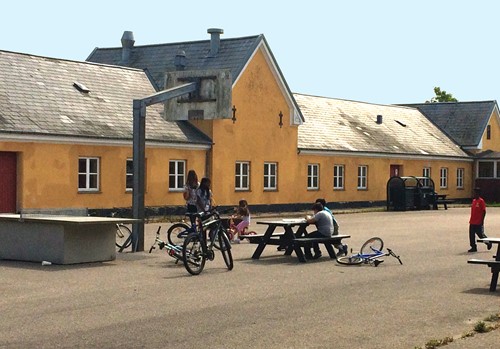Asylum centers and deportation centers
As an asylum seeker, it is not free of choice where to live. Asylum seekers have to stay in an asylum center, and Immigration Service decides which one. They can be moved from one center to another on short notice, and most asylum seekers will end up having stayed in many different centers. However, it is in some cases possible to apply for private accommodation with for instance family.
The centers are divided between different functions. Center Sandholm is reception center, and while the asylum case is pending, you are moved to one of the accommodation centers in Jutland. If you are rejected and not cooperating, you will be moved to the return- and deportation center Avnstrup (families) or one of the two deportation centers Sjælsmark or Kærshovedgård (singles people). Jelling is for people with special needs, and there are a few childrens centers only for unaccompanied minors. Finally, there is a risk of being detained in the closed prison Ellebæk as a "motivational measure" or in connection to a forced deportation. Read more about Ellebæk here.
The Danish Immigration Service pays for the operation of the centers and decides where an asylum seeker must stay. The Danish Red Cross runs about half of the centers on contract and a few municipalities are running the others centers. The Danish Prison and Probation Service runs the Deportation Centers Sjælsmark and Kærshovedgård as well as Ellebæk. See the current list of asylum centers in Denmark.
The number of asylum centers fluctuates constantly, depending on how many asylum seekers are arriving in Denmark. This leads to a great deal of relocations of asylum seekers and a constantly changing team of staff members. There is a big difference between the centers, both in terms of the residents, the physical conditions, and the ways the residents are dealt with by the staff.
The majority of the asylum centers are very isolated, usually put in abolished military barracks, training camps or sanatoriums. There is also a tendency that more centers are placed in Jutland and in thinly populated areas. This creates a great deal of frustration among the asylum seekers who do not receive adequate allowance to leave the centers. Because of the centers’ isolated locations, asylum seekers have a hard time meeting any Danish citizens, getting in touch with their family members, obtaining counseling with regard to their asylum case, and in general keeping themselves occupied. Fortunately, local Danes visit the asylum centers and offer company or activities to asylum seekers. Asylum seekers are free to come and go at will, but most centers have security control at the entrance for visitors – i.e. a visitor must be invited by a resident of the center to enter.
Most asylum seekers are single and they share a room with 3-4 other singles of same sex. Kitchens and bathrooms are located in the hallway and are often shared with 20 other residents. Families with children have two rooms and in a few centers a kitchen and a bathroom are included.
Asylum seekers have mandatory duties in the centers, such as cleaning of common areas. To some extent, an asylum seeker has access to language education in Danish or English and can apply for an internship if she/he is in Phase 2. Yet, in general it is difficult to find engaging activities and asylum seekers’ concerns about the future represent a constant struggle of their daily lives. It can also be difficult to live closely with people with different cultures and languages, and the majority of residents in asylum centers have traumas and problems to deal with. However, helpfulness and tolerance are usually more common than clashes and conflicts.
Read more in a researcher's article about the conflicting goals of the asylum centers. Room for 4 single men in center Avnstrup
Room for 4 single men in center Avnstrup
The deportation centers
Kærshovedgård and Sjælsmark were deliberately established with very few activities, to put pressure on people to give up and go home. However, the main effect is that people go under ground or travel illegally to neighbour countries. In principle, you can stay forever in a deportation center if it's not possible to return you. Until the summer 2020 families also lived in Sjælsmark, but have been moved to Avnstrup due to politic pressure. Red Cross published a report in 2019 which documented how the stay in Sjælsmark was damaging to children.
Kærshovedgård is for single people, and is placed in a forest in Ikast-Brande municipality, 7 km from the nearest public transport, in a closed down prison. Sjælsmark is also for single people and lies 2 km from center Sandholm in Hørsholm municipality. In deportation centers there is electronic registration and a duty to stay overnight, and it's very hard to obtain permission to stay a few nights outside the centers. Several times a week you have to meet up with the police for "deportation control". The residents receive 0 DKR in cash and are not allowed to work.
Avnstrup has become a joint return- and deportation centre since the summer of 2020. All the families in phase 3 live here, both the families who coorperate and those who do not. Single people who coorperate live here as well. The center is run by Red Cross, who, among other things, offer activities for children living in the centre. In the beginning of 2021 new kitchens were established, allowing the residents to cook for themselves. As residents are not getting any money, groceries can only be ordered via an online system which works in a far from satisfactory way.
Sandholm and the deportation centers have a canteen for the residents who have to eat whatever is provided there three times a day and thus get no money for food. Most asylum seekers are frustrated about this practice and it can be particularly difficult for young children. The canteen only serves one dish, is open for 45 minutes only and it is not allowed to bring food to the rooms. In Sjælsmark it is not allowed to have an electric kettle or a fridge in the rooms.
Danish Red Cross has been put in charge of the care unit in Kærshovedgård and various offers in Sjælsmark, and are doing a good job. Yet, the assignment is somewhat paradoxical, as the Prison and Probation Service is told to make life as unbearable as possible for the residents at the same time.

The canteen in deportation center Kærshovedgård
Read more:
About the deportation centers in our report 'A firm hand' by Michala Clante Bendixen (2021).
See a Reuter photo reportage from Kærshovedgård here.
Read the report 'Stop Killing us Slowly' from 2018 about the deportation centers by a group of academic researchers.


